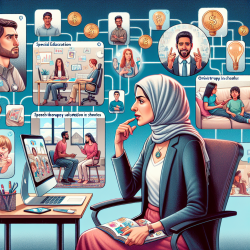Introduction
In the ever-evolving field of speech-language pathology, leveraging cutting-edge research to improve therapeutic outcomes is paramount. A recent study titled Classification of Alzheimer’s Disease Leveraging Multi-task Machine Learning Analysis of Speech and Eye-Movement Data offers groundbreaking insights that can be adapted to enhance therapy for children. While the study focuses on Alzheimer’s, the methodologies and findings can be transformative in pediatric therapy settings, particularly for online therapy providers like TinyEYE.
The Study in Focus
The research explores a novel approach using machine learning to analyze speech and eye-movement data for classifying Alzheimer’s Disease (AD). The study involved 79 memory clinic patients and 83 older adult controls, utilizing tasks such as pupil fixation and description of past experiences. Notably, the fusion of multimodal data from these tasks achieved a high classification accuracy, indicating the complementary nature of speech and eye-movement data.
Implications for Child Therapy
While the study targets AD, its implications for child therapy are profound. Here’s how practitioners can leverage these insights:
- Multimodal Data Integration: Just as the study found success in combining speech and eye-movement data, therapists can apply similar methods to assess and track children’s developmental progress. This approach can provide a holistic view of a child’s communication abilities.
- Task Innovation: Introducing novel tasks that engage children in describing experiences or maintaining visual focus can yield rich data for analysis. These tasks can be adapted to be age-appropriate and engaging for children, making therapy sessions more interactive.
- Machine Learning in Therapy: Utilizing machine learning algorithms to analyze data can help identify patterns and predict developmental outcomes, allowing for personalized therapy plans tailored to each child’s unique needs.
Encouraging Further Research
Practitioners are encouraged to delve deeper into the integration of speech and eye-movement data in therapy. Conducting further research in pediatric populations can validate and refine these methods, ultimately enhancing therapeutic efficacy.
Conclusion
By adopting innovative data-driven approaches, therapists can significantly improve outcomes for children. The study on Alzheimer’s Disease provides a compelling framework that, with adaptation, can revolutionize child therapy. Embracing such advancements not only enriches therapeutic practice but also empowers children to achieve their full potential.
To read the original research paper, please follow this link: Classification of Alzheimer’s Disease Leveraging Multi-task Machine Learning Analysis of Speech and Eye-Movement Data.










